Travel: In the Land of the Thunder Dragon
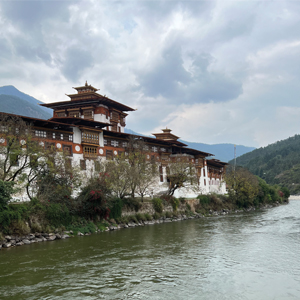
[Left] Punakha Dzong
Bhutan measures Gross National Happiness as a metric of its well-being. Gross Domestic Product is less important, and the author’s week-long trip was proof that one could be happy without the trappings of capitalist consumption we all take for granted. Everywhere she and her husband went, they were surrounded by kind gestures, smiling faces, and a pervasive sense of simplicity and serenity.
You know you are in a special place when you begin taking pictures soon after you land, right on the tarmac. Bhutan’s Paro International Airport, nestled in the Himalayas, is like the country itself. Since it is at an elevation of over 7000 feet in a narrow valley, the approach into the airport is not easy and only a handful of pilots are trained to fly into Paro. After an exciting descent, we took photographs not because we were relieved at having landed safely but because the slightly overcast sky provided a beautiful canvas to showcase the majestic mountains all around us.
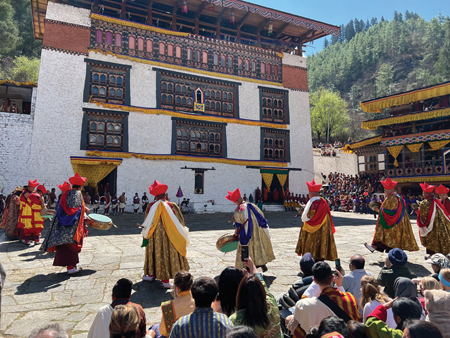 Having landed just as the Paro tshechu (festival) began, the road from the airport was full of crawling cars while locals in festive clothes crisscrossed our path. Our tour guide and his assistant, both dressed in gho (traditional attire), seemed unperturbed. “It’s not usually like this madam,” the guide insisted. “People from all over the country have arrived for the festival and since there are no trains or convenient buses, most people have driven here.”
Having landed just as the Paro tshechu (festival) began, the road from the airport was full of crawling cars while locals in festive clothes crisscrossed our path. Our tour guide and his assistant, both dressed in gho (traditional attire), seemed unperturbed. “It’s not usually like this madam,” the guide insisted. “People from all over the country have arrived for the festival and since there are no trains or convenient buses, most people have driven here.”
[Right] Paro festival
Despite the dense unmoving traffic, there was no honking or illegal lane crossings. At first, we didn’t mind. We passed a large festival market with Ferris wheels, food stalls, and live music. The colorful outfits and general holiday atmosphere were hard to miss. But as the minutes turned to over an hour, I felt impatient. We had been traveling all day and were keen to arrive at our hotel. The irony of my impatience in this land of patience wasn’t lost on me.
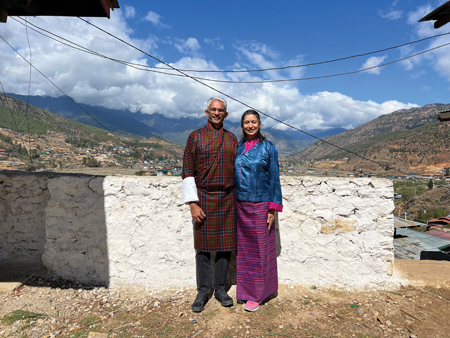 We took a break at the lovely Mountain Café, where we sipped hot cups of honey ginger tea and snacked on spicy peanut chaat, which gave us our first taste of the fiery Bhutanese red chili. We also stopped at a clothing store to pick up the traditional gho and kira attire for ourselves. It was dark by the time another route brought us to Thim Dorji Resort, a brand-new property. We were welcomed with tashi khaddar, a traditional white scarf, and a warm drink. Our room, a generous junior suite at one end of the U-shaped building, overlooked the gently flowing Paro River.
We took a break at the lovely Mountain Café, where we sipped hot cups of honey ginger tea and snacked on spicy peanut chaat, which gave us our first taste of the fiery Bhutanese red chili. We also stopped at a clothing store to pick up the traditional gho and kira attire for ourselves. It was dark by the time another route brought us to Thim Dorji Resort, a brand-new property. We were welcomed with tashi khaddar, a traditional white scarf, and a warm drink. Our room, a generous junior suite at one end of the U-shaped building, overlooked the gently flowing Paro River.
[Left] The author and her husband
After an early breakfast, and some help with our traditional outfits, we headed to the Paro Dzong (fortress), where a large crowd had gathered in an open field to witness traditional dances. Every local family, including grandmothers with short silver hair and tiny tots, were dressed up in the gho and kira. It was a beautiful spring day with cloudless clear blue skies. The sun was sharp against our skin and we wore sunglasses to shield our eyes against the intense glare. We watched a series of performances featuring men and women dressed in fine costumes, accompanied by various drums and instruments. In Bhutanese Buddhist culture, attending the performances at festivals at various fortresses is believed to generate merits (good karma), remove bad energy, and bestow blessings.
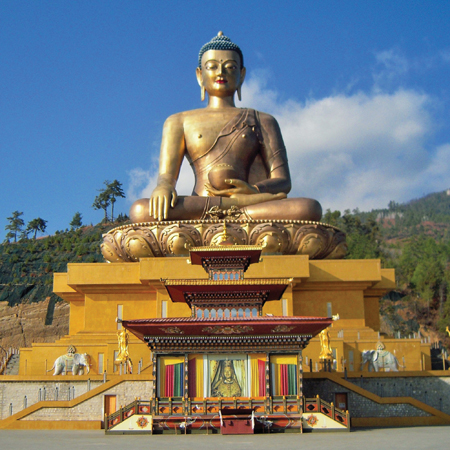 A unique capital city
A unique capital city
From Paro, we headed to the capital city, Thimphu, about 50 kilometers away. Every car ride in Bhutan takes you on winding roads through mountain ranges. We stopped at Buddha Point, where a gigantic golden statue of Buddha measuring 51 meters overlooks the Thimphu Valley. The majestic statue in the bhumisparsha mudra, with the left hand facing upwards and the right hand touching the earth, inspires awe. Constructed with donations from businessmen from Singapore, Hong Kong, and elsewhere, and consecrated in 2015, this relatively new temple is believed to have been prophesied by Guru Rinpoche in the 15th century.
[Right] The Buddha Dordenma statue at Buddha Point
As the sun glinted off the series of gold-plated dakinis on the periphery, strong gusts of wind tempered the bright sunshine as we looked around at Thimphu town sprawled across the valley. Enamored by the serene beauty of this hill, we returned here later in the week to walk a trail that took us through a forest of cypress, blue pine, oak, and flowering magnolia trees.
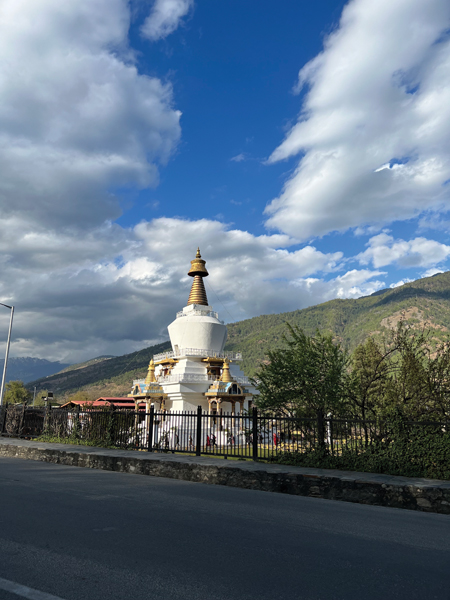 As the workday ended, we entered Thimphu, the only capital in the world without a traffic light. How does a city manage without traffic lights? You have to see it to believe it. In fact, the only traffic island has a human traffic light, a person who directs traffic around the tiny circle. People cross streets only at designated zebra crossings and cars move around carefully and graciously, making way for each other.
As the workday ended, we entered Thimphu, the only capital in the world without a traffic light. How does a city manage without traffic lights? You have to see it to believe it. In fact, the only traffic island has a human traffic light, a person who directs traffic around the tiny circle. People cross streets only at designated zebra crossings and cars move around carefully and graciously, making way for each other.
The National Memorial Chorten and its golden spire was brilliantly lit by the evening sun. As the temperature plummeted, we stepped inside the well-maintained building that housed various shrines and statues. We walked around and, like the locals, spun the large prayer wheels.
[Left] Thimpu Chorten
At Norzim Lane, we stepped into several shops selling traditional Buddhist handicrafts including shawls, scarves, baskets, souvenirs like magnets, T-shirts, bracelets, etc. Later that night we visited the market where local seasonal produce including fiddlehead ferns and asparagus were sold alongside organic turmeric, rajma, and Bhutanese chili in various forms including powders, pastes and pickles. It felt surreal to walk through a capital city which had no billboards or posters featuring familiar chains like McDonald’s or even ubiquitous brands like Nike.
Visiting Punakha
The route to Punakha took us through Dochu La, a mountain pass located 3150 meters above sea level. At 8 a.m. the entire area including the parking lots and the 108 memorial chortens (stupas) known as Druk Wangyal chortens were cloaked in a thick sheet of fog. As we walked in the slow-moving fog to a painted meditation cave, passing daphne trees festooned with hanging lichens, and arrived at a circular structure representing the wheel of life with a dried hemlock tree at its center, I was reminded of old Bollywood thriller movies.
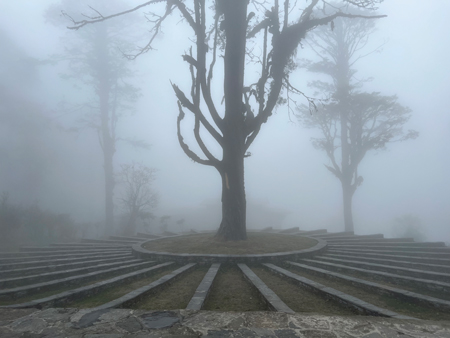
The visibility was still poor when we made our way out of the crowded parking lot for our first activity of the day, a river rafting adventure. Punakha’s landmark, the Punakha Dzong, sits at the confluence of two rivers, Mo Chu and Po Chu. We made our way to a point upstream of Mo Chu, the feminine river, where our rafting crew awaited us. This stream was more suitable for the easy rafting that we had in mind. We learned to respond to the crew’s four common commands: forward, backward, stop, and hold on. The beautiful mountains around us, along with crested kingfishers, flying wagtails, and flowering trees, made the entire stretch feel like a meditation session.
[Right] Foggy Dochu La Pass
The Punakha Fortress, filled with history and devotion, is an intimidating structure. Like other dzongs, it is located on a riverbank. There are several courtyards, each serving a different purpose. A large bodhi tree dominates the first courtyard, which has rooms along the sides for monks to study, pray, and discuss the texts. In the main hall, hundreds of monks, many of them young boys, continuously chanted “Om Mani Padme Hum,” Tibetan Buddhism’s most ubiquitous mantra. Combining gratitude with compassion, it created an inner sense of peace.
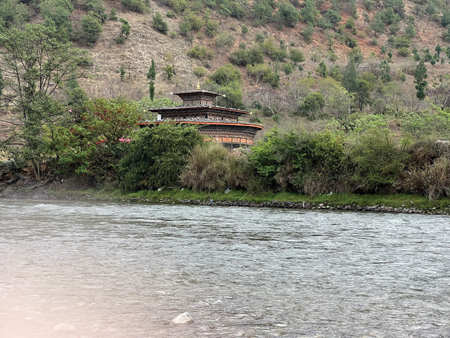
[Left] Punakha River
In case you think Bhutan is a place for older and/or celibate people, think again. Our last stop of the day included a visit to Chimi Lakhang at the edge of Punakha Valley. This temple, built in the 15th century and blessed by the maverick saint Drukpa Kunley, is also known as the Temple of the Divine Madman. While we were offered holy water at other temples, here we were blessed by an artefact that looked like a giant phallus. Yes, that’s right. All along the winding roads approaching the temple we saw phallus symbols of various sizes and colors adorning the walls of houses, fences, and doors leading to homes and other businesses. This is a place where childless couples come for blessings. We spent a night at Punakha Valley and another one at Gangtey before heading back towards Paro for the most difficult activity planned for this trip.
On to Tiger’s Nest
The crown jewel of Bhutan tourist brochures is Taktsang, also known as Tiger’s Nest, a monastery nestled at an altitude of 3000 meters above sea level. Since Paro International Airport is located in a valley, most tourist itineraries put the Tiger’s Nest hike on the penultimate day of the trip. Why? Because the entire country, even the valleys, are at an altitude of over 2000 meters, and a hike that takes you even higher requires some degree of acclimatization.
I was physically and mentally prepared for the hike. I had a sturdy pair of shoes, a hiking pole, jacket, sunglasses, a hat, and a bandana. My husband and the guide carried water bottles and some snacks to help us stay hydrated and energized for the day-long trek. The guides scamper up the slopes and steps like lithe mountain goats while tourists start, pant, stop, and wonder if they will make it. While you can ride a horse up to a midway point, you have to walk the last stretch.
All employees of the tourist industry, our guide told us, had come together during the pandemic to clean up and refurbish the major tourist locations. Thanks to their efforts, the trail was in a great shape when we climbed. Stopping whenever I had to catch my breath, I leaned against the hillside or sat on one of the benches along the path, pacing myself for the long trek and determined to complete it. My only competition was with myself.
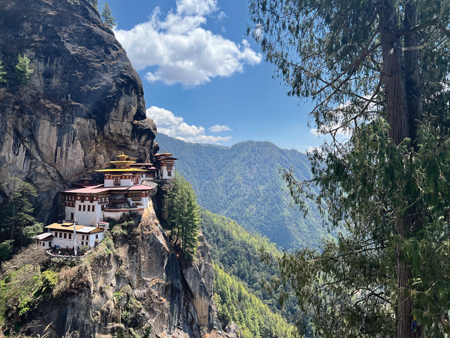
[Right] Taktsang (Tiger’s Nest)
Just before the stretch with steps begins there is a viewpoint from which most photos of Tiger’s Nest are taken. You can see it but there is still a tough path ahead. It is a metaphor for most things in life. Our destination is within reach, and our goals are close to being accomplished, but there is the last mile, the toughest part of the journey. What do you do? Complete the course or turn back? I used the same technique of pacing myself without regard to the speed of others as I navigated the steps. I silently chanted “Om Mani Padme Hum” as I stepped up, focusing on my core, on the manipura chakra, and prayed for physical ease and assistance. Along the way we came across groups, families, and couples with varying degrees of commitment. Some went ahead, while many others who looked younger and fitter than me turned back.
While I would like to claim that I completed the trek with my own determination, I know there was some degree of divine grace too. The monastery has several shrines, each of which required climbing up another set of 10-20 steep steps. This was when I felt exhausted but carried on. Each shrine was filled with the same aura of peace that is Bhutan’s quintessential quality. It permeates every inch of this jewel nestled in the mountains, whether it is in public spaces or tucked away temples. On the way back, I felt lighter somehow as I ascended the steps and then descended the slopes all way back to the parking lot where our car awaited us. I had done it!
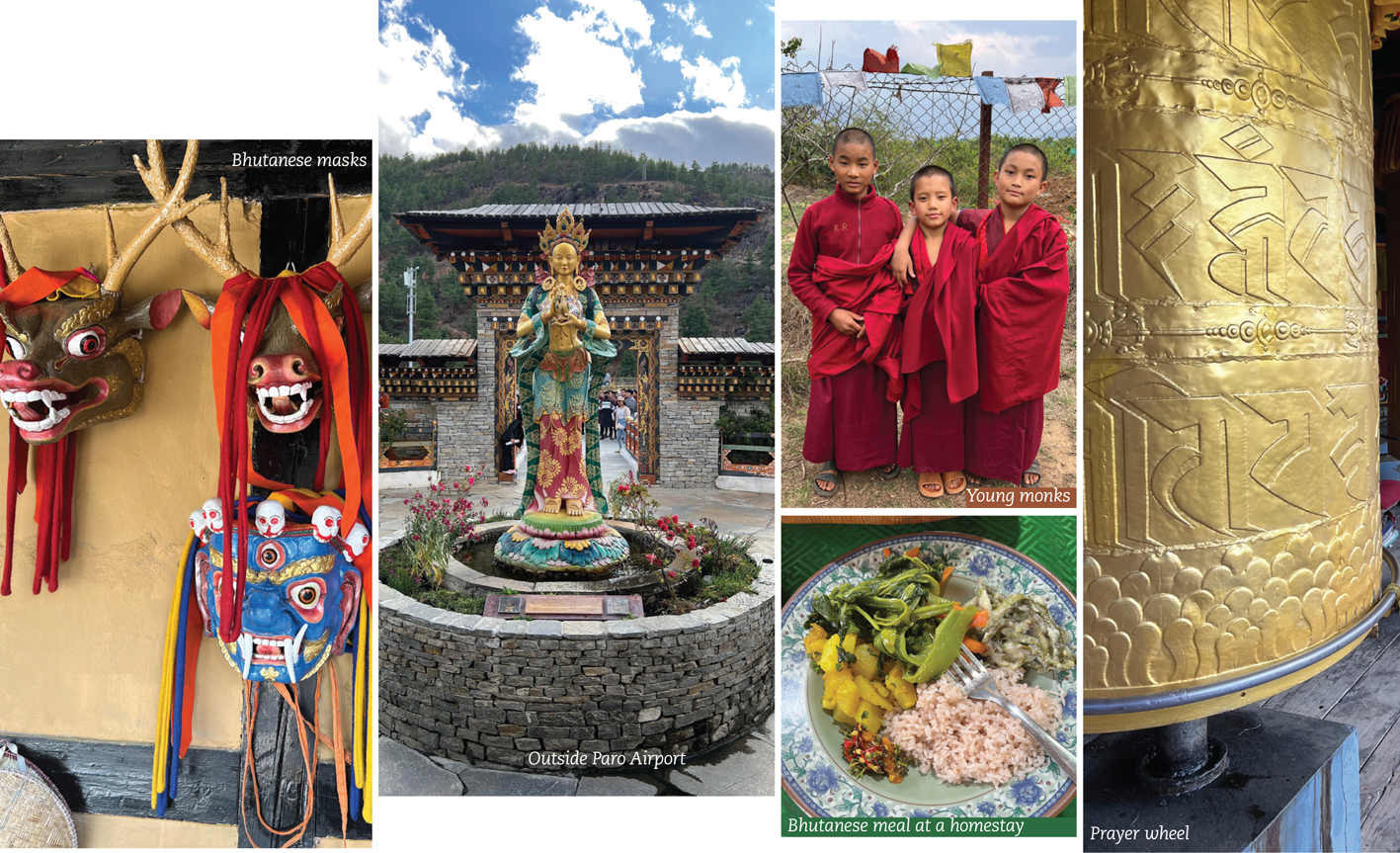
Would I do it again? Absolutely. But here is a tip if you plan to trek to Tiger’s Nest. Schedule your hot stone bath experience right after the trek. We did. To my great surprise, I had no stiffness or pain the next day as we boarded our early morning flight back to Singapore. Bhutan is truly more than just a country. It is a feeling that you can collect and carry back with you. It is proof that you can create your own authentic oasis in a world that seems to have lost its bearings. If you are looking for an out of the ordinary travel experience, make a trip to Bhutan.
Ranjani Rao is the author of Rewriting My Happily Ever After: A Memoir of Divorce and Discovery and The Coherent Writer newsletter. Email: letters@khabar.com
Enjoyed reading Khabar magazine? Subscribe to Khabar and get a full digital copy of this Indian-American community magazine.
blog comments powered by Disqus










